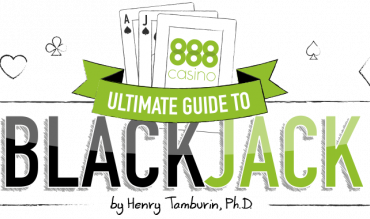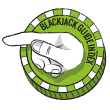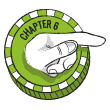BLACKJACK ODDS: HOW TO FURTHER REDUCE THE HOUSE EDGE

The strategy charts and tables presented in Chapter 3 will decrease the house against you when you play blackjack to around 0.5% (rule dependent). In this chapter, I’ll show you five additional techniques that could further reduce the house edge.
COMPOSITION-DEPENDENT STRATEGY
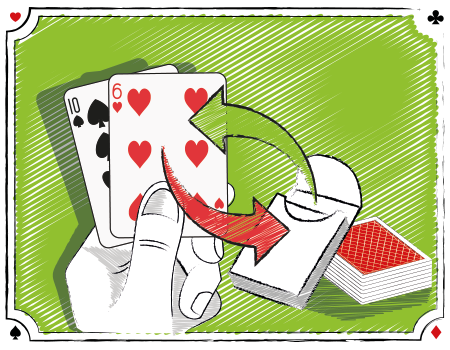
The basic strategy presented in Chapter 3 considered just the total of all the cards in your hand, without any consideration of the individual cards that comprise the total, known as Total-Dependent or T-D basic strategy. The latter is also more commonly referred to as the traditional basic playing strategy. There is nothing “wrong” with this basic strategy; however, you can gain extra precision (i.e., slightly lower house edge) if you consider the composition of the cards in your hand, known as Composition-Dependent or C-D basic strategy.
Actually, C-D basic strategy has been around for a long time, having first been proposed in 1979 in the classic book The Theory of Blackjack by the late blackjack mathematician Peter A. Griffin. More recently, additional information on C-D basic strategy can be found in the book Blackjack Attack: Playing the Pros’ Way by Don Schlesinger; The book Blackjack Bluebook II by Fred Renzey; and Don Schlesinger’s commercially available Ultimate Blackjack Strategy Cards.
Developing a strategy chart or table with all of the possible composition-dependent strategies would be pages long and virtually impossible for an average player to learn. However, what follows are a few composition-dependent plays that you can readily learn and use to make you a tougher player.

BLACKJACK ODDS: 16 AGAINST DEALER 10
If I asked you how you would play the following hands against a dealer’s 10 upcard what would be your answer? Assume surrender is not offered; if surrender is offered, you should surrender all two-card hard 16s against a dealer’s 10 upcard except 8-8.

According to the (T-D) strategy charts and tables in Chapter 3, you would hit the first three hands and split the 8s. However, what the T-D basic strategy doesn’t consider is the makeup of the hand. It turns out there is a difference between a 16 made up of two cards, such as 10-6 and 9-7, and one made up of three cards, such as 4-5-7. All three hands total 16, but with a three-card 16, you are better off standing, whereas with the two-card 16, you should hit.
The reason you should stand on a 16 when your hand contains three or more cards is because your hand contains one (or more) small-value cards that are no longer available in the pack of unplayed cards. These small cards are exactly what you need to make a pat hand when you hit your 16. The fact that a few of them just landed in your hand is enough to shift the odds toward standing rather than hitting.
Fred Renzey, author of Blackjack Bluebook II, states the following in his book: “Against a 10 up, if your 16 contains any 4’s or 5’s, then stand.” Blackjack author Don Schlesinger takes this rule one step further with his Ultimate Blackjack Strategy card, where he states: “Stand if 16 is multi-card, or the result of a pair split.”
According to Schlesinger, “When all multi-card 16s are taken into account, and the edges are weighted, it is wiser to stand on all of them rather than hit on all of them. There are some exceptions, but their level of complexity was too great to be enunciated on the strategy card."
This is how I would recommend you play your hard 16, assuming surrender is not available, to improve your playing precision for this hand:
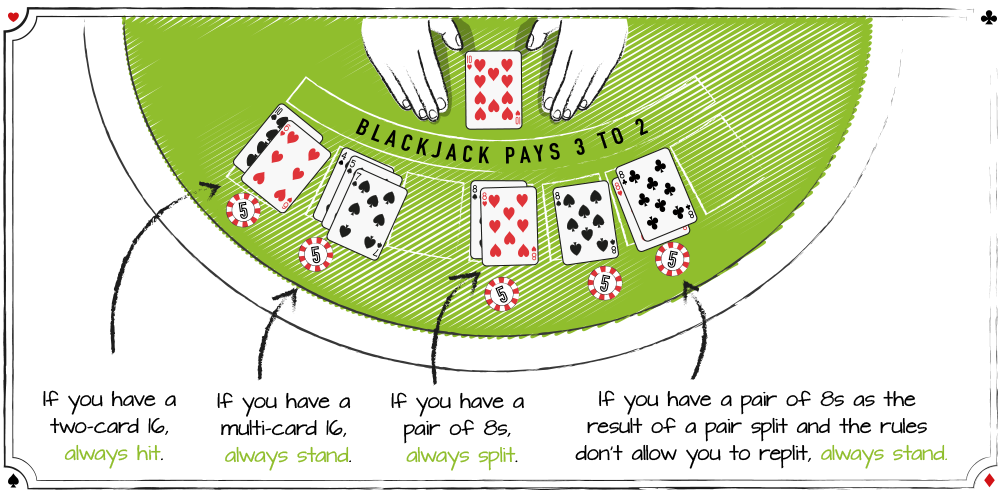
BLACKJACK ODDS: 12 AGAINST A DEALER 4
Another hand where your strategy is dependent upon the makeup of the cards is a starting total of 12 against a dealer’s 4 upcard in games with S17. Total-dependent basic strategy states to stand on 12 against a dealer 4. But there are, in fact, four different ways to be dealt a 12: 10-2, 9-3, 8-4, and 7-5 (6-6 would be considered separately, as a pair to be split), and in the specific case of 10-2, you are slightly better off hitting against the dealer’s 4, whereas with 9-3, 8-4, and 7-5, you are better off standing.
Schlesinger says, “By having just one ten-value card in your hand when you hold a 10-2, you slightly lower your chances of breaking with a hit just enough to tip the balance in favor of risking busting by drawing one more card, rather than standing. This effect, however, diminishes as the number of decks increases, because removing one ten out of 16 is a lot more dramatic than removing one ten out of 128 for an eight-deck game. Therefore, for six or fewer decks, it’s best to hit a 12 consisting of 10-2 against a dealer’s 4 upcard, but in an eight-deck game, it’s best to stand.”
I would recommend that you use the following strategy when you are dealt a 12 against a dealer’s 4 upcard:
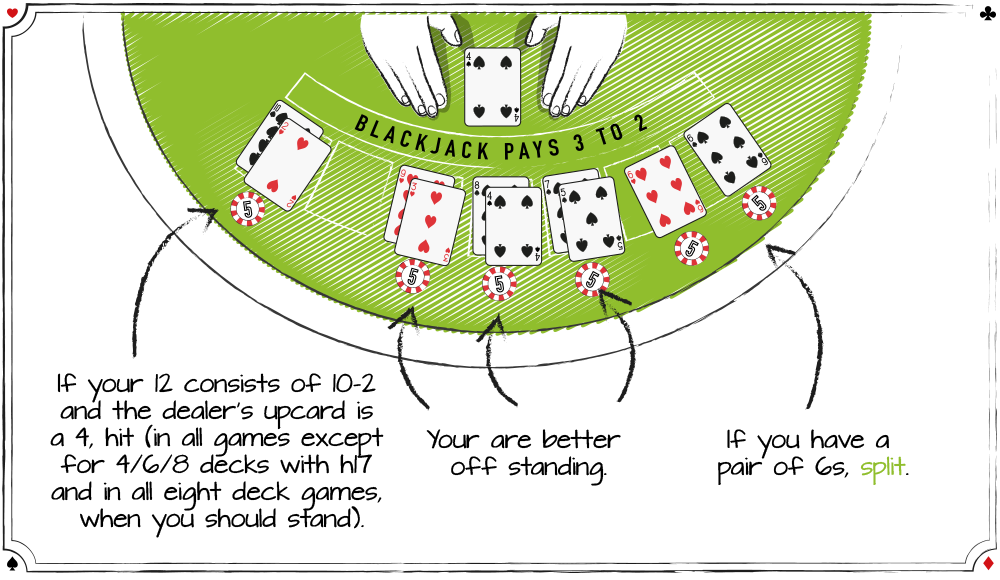
BLACKJACK ODDS: 15 AGAINST A DEALER 10
The T-D basic strategy states to surrender 15 against a dealer’s 10 upcard; however, I would recommend you use this C-D strategy:
When your 15 consists of an 8-7, you are slightly better off hitting than surrendering (except surrender in 7 or more decks).
The reason you hit rather than surrender 8-7 is that your chance of busting the 15 is slightly reduced after you’ve removed the 8 and 7 from play, as receiving either of those two cards would bust your hand, which is not the case for 10-5, or 9-6. This tips the scales just enough to make hitting 8-7 a slightly better play than surrendering. In technical terms, your expectation is higher than –50% when you hit, which is better than the exact –50% expectation when you surrender. This means you will lose less money in the long run when you hit 8-7 against a dealer 10 than when you surrender.
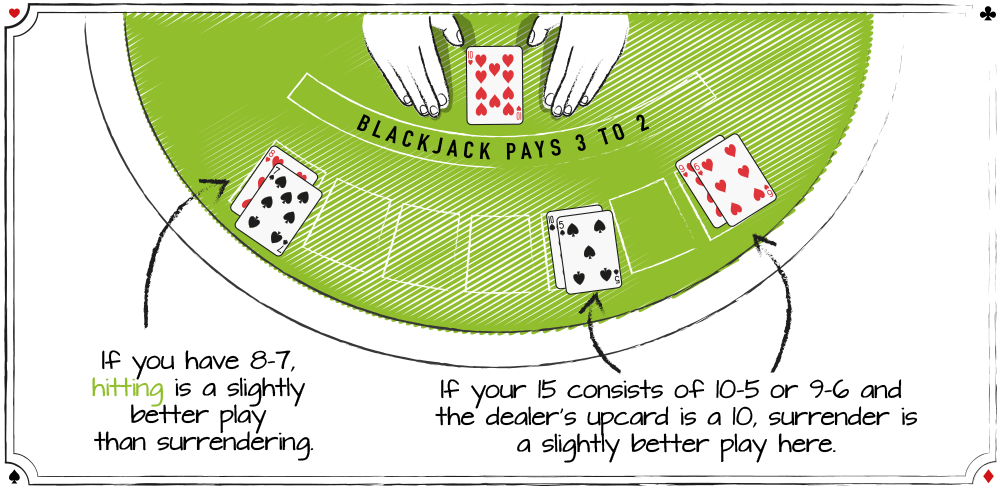
PERCENT REDUCTION IN HOUSE EDGE
By way of an example, according to Schlesinger, if you incorporate all of the C-D strategy on his strategy card for a double-deck game with S17 and DAS, the house edge can be reduced by 5.3% compared to the traditional T-D basic strategy (from 0.19% to 0.18%). For more information on the effect of the C-D basic strategy on the house edge compared to the T-D basic strategy, see Table A1 in Schlesinger’s book.
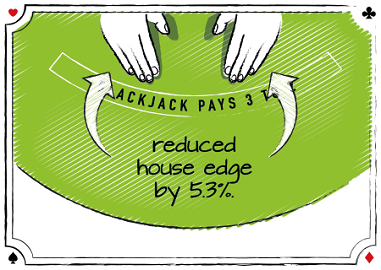

BOTTOM LINE
I would recommend you learn the above three C-D plays and use them when you play blackjack. The 16 vs 10 play occurs frequently, so at the minimum, learn the C-D strategy for that play.

HAND INTERACTION
Hand Interaction is a technique that was made popular by blackjack author Fred Renzey in his book Blackjack Bluebook II. Renzey also wrote about this topic in several issues of my Blackjack Insider e-Newsletter. I’ll explain what hand interaction is, and briefly discuss why some players believe some of it is “controversial.”
Hand interaction is a strategy that basic strategy players can use to reduce the house edge (blackjack odds) against them and it will affect on how to play the game. It is not a technique for the timid player because you will be making a bet on another player’s hand or asking a player to bet on your hand. Why would you do so such a thing? The short answer is: To seize the edge on the hand.
There are five different types of hand interaction.
They include:
- Taking part or all of another player’s profitable double.
- Giving away part of your own unprofitable split.
- Taking part of another player’s profitable split.
- Buying or collaborating on another player’s advantageous hand.
- Making profitable side bets with another player’s hand.
I’ll describe a few of these hand interactions
so you understand how they work.

EXAMPLE #1

Suppose the player next to you bet $20 and was dealt the following hand:
The correct basic strategy play is to double down. However, suppose the player next to you hesitates to double down because the dealer is showing a strong 10-value card. The player finally decides to double for less (a bad play) and pushes out two red ($5) chips. Before the dealer gives the player his draw card, according to Renzey you should toss two more red chips to the player and tell him you’ll cover the rest of the double down. Note: You hope that the player will allow you to do this; according to Renzey, most do.
What’s the point of doing this? Since the player was not going to take full advantage of a profitable double down play, you should go ahead and try to take part of the advantage that he is about to pass up. If the double down wins, your $10 would net you an additional $10.

EXAMPLE #2

Suppose the player to your right wagered $25 and was dealt:
Your fellow player has a blackjack but the dealer is showing an Ace. The player has the option to ask for “even money”, which means he would be paid even money for his blackjack, regardless of the outcome of the dealer’s hand.
Taking even money is not a smart play, unless you are counting, but many players do it because of the “bird-in-the-hand” adage. Renzey suggests that when a player has this hand, you should blurt out, “I don’t think she’s got a blackjack this time ... here, I’ll buy your hand for even money.” Then you toss the player chips equal to the amount that he bet. The player is happy because he gets his original bet back plus an equivalent amount as profit on his blackjack. Now you “own” his hand, and you will either be paid 1.5 times the bet from the dealer if she doesn’t have a blackjack, thereby winning half of the bet, or get nothing if she has a blackjack, thereby losing the full bet. However, in the long run, this will be a profitable play because the dealer will more than twice as often not have blackjack and you’ll get paid at 3-2 odds.

EXAMPLE #3
Here’s an example of a hand interaction that is considered by some to be controversial because you are trying to convince another player to take over part of your bad hand.
Suppose you are dealt the following hand:
Renzey proposes that you should look uncertain as to how play this hand and then ask your fellow table players how they would play it. Someone, usually a player who believes he’s an expert, will tell you to split; however, according to Renzey, “they don’t know that even the correct move is a money loser rather than a money maker.” So you should ask the “expert” if he wants to go partners on your split, i.e., he puts up the secondary wager for the split. If he agrees and Renzey claims many will, you’ve relived yourself of half the financial liability of a losing hand.
Renzey lists six other splits in his book where you can save money if you can manage to pawn off half of your split hand to another player. Is this an ethical thing to do when you play blackjack, namely, to improve your expected value at a cost to other players? Renzey addressed this in an article he wrote in issue #88 of BJI “The Ethics of Snookering Players at Your Table”. He wrote:
“Some players will say that it’s us against the house, and that ‘snookering’ another player would be like betraying a teammate. Others will be quick to point out that blackjack is not a team sport, and making ‘deals’ on the table is condoned by the casino ... [so] the sharper wheeler-dealer comes out on top.”
There are other hand interactions described by Renzey in his book and in his articles in the Blackjack Insider e-newsletter. If you want to learn more about them, I encourage you to check out these resources.

HOUSE EDGE REDUCTION
According to Renzey, “although it’s quite a stretch, if you combine hand interaction along with basic strategy, it’s technically possible to gain an overall advantage in blackjack.”

CASINO COMPS
Getting rated and asking for comps while you play blackjack is another technique that can reduce the house edge against you.
“Comp” is short for complimentary. It’s the nice perks that casinos give you just for playing. Depending upon your betting level and how long you play, you could get comped to a buffet, a café, a gourmet room, a hotel room, a suite, even air fare. But here’s the key: by playing blackjack you can get the most in comps compared to other casino games, and the value of the casino comps can often eliminate, and sometimes exceed, the house edge against a basic strategy player. Here are inside tips on how this is done.

HOW TO GET RATED
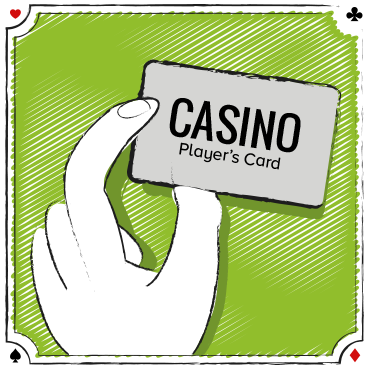
Speaking of casino comps, it’s your responsibility to ask the floor supervisor for a comp when you are done playing. Ask nicely, and don’t be upset if he doesn’t extend to you what you expected. Don’t expect a comp to a gourmet restaurant if you are betting only $5 a hand for an hour. Your best bet is to get a casino host and find out from her what should be an average bet and length of play to order to receive a specific level of comps (or casino coupons).

HOW MUCH IS YOUR ACTION WORTH?
Casinos will give players a comp based on their perceived worth to them. They calculate a player’s “worth” based on the following formula. Let’s assume you are a $10 basic strategy player and you are going to play blackjack for five hours. We’ll assume you be dealt 100 hands per hour, about right for a table with a few players. Your total action or the amount you will bet is:

Using the calculated amount of action (i.e., $5,000), the casino will use the following formula to compute how much of a player’s action they expect to win.

Since casino supervisors, those folks inside the blackjack pit, can’t watch the play of every individual blackjack player to determine his or her skill level, they generally will assume a 2% advantage over the masses of players that play blackjack. This assumes most players aren’t using the basic playing strategy when they play, and the house edge against them, depending on how poorly they play their hands, is at least 2%. This means the casino expects to win about $100 in the above example.

The casino has estimated your worth to them as $100 (i.e., the calculated amount that they expect to win from you). Most casinos will rebate between 20%–40% of your worth to them. I’ll split the difference and assume 30%, meaning the casino will give you a comp worth $30.

Now think about this. The casino has estimated that you are going to lose 2% of your action when, in fact, because you are a skillful basic strategy player, your theoretical loss is roughly half a percent, of course, this depends upon the rules, as explained in Chapter 3.
So let’s recalculate the basic strategy player’s expected loss in the above example with only a 0.5% casino edge:

Do you see where this is heading? The casino floor supervisor has the player earmarked for a $100 theoretical loss so he doles out a comp worth $30. Meantime the basic strategy player’s actual expected loss, with only a 0.5% house edge, is only $25. The skillful basic strategy player has just received more in casino comps (and casino coupons) than his theoretical loss from playing. In this example, the basic strategy player has a monetary advanatge over the casino.

MORE TIPS TO GET EVEN MORE CASINO COMPS
If you think the above is a good deal, here are some tips to make it even better.
- Instead of playing 100 hands per hour, S-L-O-W down your play at the tables. You can do this by playing at crowded tables instead of a table with only a few players. Take your time making your playing decisions. Skip a few hands and take a few “restroom” breaks. The point is that if you slow down your play so that you are betting on only 50 hands per hour, instead of the 100 hands the casino will be rating you for, your expected loss in the above example drops to $12.50 and you are still getting $30 worth of casino comps. Now you’re ahead by $17.50 instead of $5.
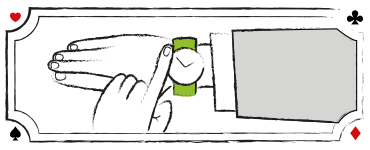
- If you play in very favorable games with very good rules it’s possible to reduce the casino’s edge to less than 0.5% with basic strategy (see Chapter 3). The lower you reduce the house edge against you, the greater the value of the comps the casino will be giving you.
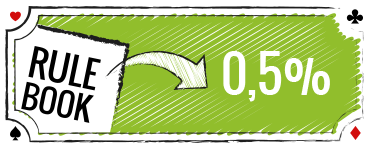
- The floor supervisor will usually record the first bet you make on your rating card. Now would be a good time to bump up your bet to, say, $25. That larger bet will be recorded on the rating card, which will bump up your rating and subsequent value of your casino comps. Your disadvantage off the top of a freshly shuffled deck is minimal so this subterfuge is not very costly.
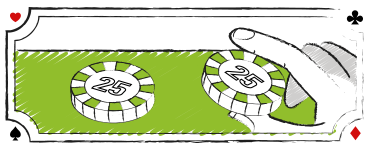
- When you are done playing, ask the floor supervisor what he has rated you for an average bet. If he says an average bet of, say, $15, bring to his attention the fact that you have been varying your bets from $10, say, up to $30 or whatever your top bet was. Floor supervisors don’t want disgruntled players so, most of the time, they will bump up your average bet to keep you happy. When he increases your average bet that translates into a comp with a greater value.
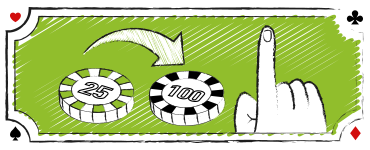
There are other tricks to getting more value in comps for your perceived skill and betting level when you play blackjack. In fact, books have been written about how to go about this, two of the best are the second edition of Comp City by Max Rubin, written for the high roller, and The Frugal Gambler and More Frugal Gambling by Jean Scott, which is geared more to the low roller.
Note: I don’t want to leave you with the impression that the above techniques will “always” work. There are some casinos that will rate you at less than 100 hands per hour even if you are playing alone at the table. Others may monitor how well you play, and if they conclude that you are a perfect basic strategy player, they will reduce your 2% loss rate. Any of these adjustments can reduce the dollar value of your casino comps to where you won’t have a monetary edge. However, it’s still worth trying to get more casino comps and coupons, than you deserve by using the above techniques simply because nothing ventured, nothing gained.

CASINO COUPONS
Using gambling coupons when you play blackjack allows you to have the edge even if it’s for only one bet. There are many different types of casino coupons and several sources where you can get them. I’ll explain the different types of casino coupons, what their value is, and where you can obtain them.
PROMO CHIP
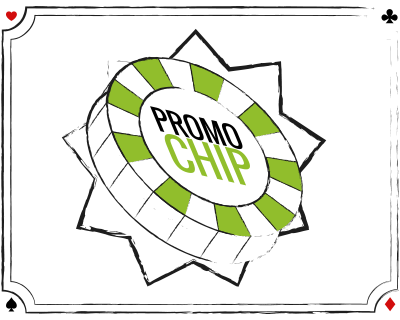
One of most popular casino coupons given out by casinos isn’t even a coupon, it’s the Promotional Chip, known as a Promo Chip. These chips are sometimes given to players as a reward for playing on a regular basis, or as an incentive to entice a player to return to a casino. Often, the Promo Chip is offered to a player in a casino mailer.
The Promo Chip can be bet at blackjack in place of a regular casino chip and it is removed by the dealer after the bet is resolved. This means that, if a player wins the hand, the dealer will take the Promo Chip and pay off the winnings with a regular casino chip.
If the hand loses, the Promo Chip is removed by the dealer and the player wins nothing.
If the hand ties, the player usually gets to keep the Promo Chip to bet again on another hand. If a player bets a Promo Chip and wants to double or split, he must use regular casino chips.
According to another blackjack source, a Promotional Chip has a value equal to 51.2% of the value of the chip when bet at blackjack. This means that, say, a $100 Promo Chip has a value of $51.20. Not a bad way to gain the edge on one hand.

MATCHPLAY COUPONS
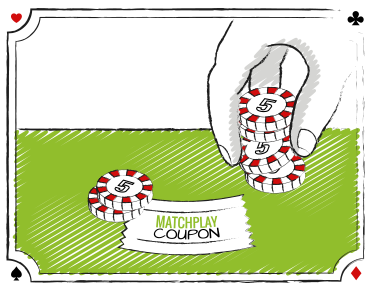
Matchplay coupons and sometimes chips are also common. A matchplay is essentially a bet made on your behalf by the casino. Here’s how it works.
Say you place a $10 chip at a blackjack table along with a matchplay coupon. If you win the hand, you get paid double – $10 in winnings for the bet made with the $10 casino chip and another $10 in winnings for the matchplay coupon. If you lose the hand, you lose only $10 of your own money. In either case, a matchplay coupon can be used only once except if the hand ties, you can use it again, and once a decision is rendered, the dealer will take the matchplay coupon and place it into the drop box.
Note: When you use a matchplay and want to double down or split the hand, you can do so only on the original $10 bet. The value of a matchplay coupon is 46.2% of the face value of the coupon, e.g., a $10 coupon has a value of $4.62.

BLACKJACK BONUS COUPON
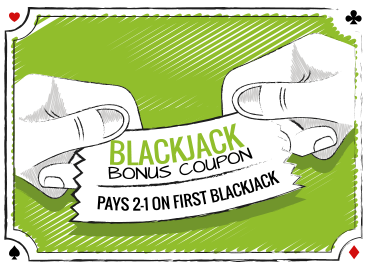
Another valuable coupon is the blackjack bonus coupon that pays 2-1 on your first blackjack. You should only use this coupon on a table where a blackjack payout is 3-2 (not the atrocious 6-5).
Normally you will get paid 1.5 times your bet at a 3-2 game, but when you use the 2-1 coupon, you will get paid an extra 0.5 units, e.g., bet $10 and when you are dealt an untied blackjack, you’ll be paid $20 instead of $15.
Statistically, you’ll get a blackjack about once in every 21 hands on average. To determine the value of a 2-1 blackjack coupon, you have to take into account not only the 0.5 unit bonus payout but also what it cost you on the house edge for the average 21 hands you waited until you got the blackjack. According to James Grosjean (author of Beyond Coupons), in a typical six-deck game with dealer standing on soft 17, a 2-1 Blackjack Coupon with a face value of $25 is worth $10.25.

HOW TO OBTAIN GAMBLING COUPONS
There are several ways you can get obtain gambling coupons.

Two publications that contain blackjack and other casino coupons for Las Vegas casinos are the Members Rewards book that you get when you purchase an annual subscription to the American Casino Guide book by Steve Bourie.
As an example, the 2015 American Casino Guide book contains the following blackjack coupons for Las Vegas casinos:
- $25 matchplay for new club members at Golden Gate and the D.
- $10 matchplay at the Downtown Grand, Gold Coast, Hooters, Lucky Club, Orleans, The Palms, Riviera, and Tuscany.
- $5 matchplay at Bighorn, Ellis Island, Las Vegas Club, Jerry’s Nugget, Longhorn, and Rampart.
The list of blackjack coupons in the 2015 Members Reward booklet for Las Vegas area casinos includes:
- $25 Matchplay at the D, Downtown Grand, and Golden Gate.
- 2-1 payoff on first blackjack up to a $25 bet at Silver Sevens.
- $10 Matchplay at Palms, Gold Coast, Plaza, and Orleans.
Another interesting blackjack coupon that you can use at the D Las Vegas is the “Push your Bet at 22” (available in both publications). You can wager up to $25, and when your hand totals 22 for the first time, your bet is pushed. According to Anthony Curtis, this coupon is worth $22 when played with a $25 bet; the slight decrease in value is the cost of the waiting bets you must make due to the house edge, until you get a 22.
Organizing a “coupon run” where you visit several casinos located close to one another while using several blackjack and other casino coupons is a fun way to play with an edge.
Note: Before you use any blackjack coupon, make sure you read the instructions on the coupon. You should also visit lasvegasadvisor.com and www.americancasinoguide.com for an up-to-date listing of casino coupons for years 2016 and beyond.

LOSS REBATE
This technique involves negotiating a rebate on your gambling losses when you play blackjack so that you can create an edge over the casino. This technique is used mostly by high rollers since it involves betting large amounts of money on each hand and negotiating a sweet deal with casinos that will give you the advantage.
I realize this technique can’t be used by average gamblers but I’ve included it in this guide to show you how far skillful players will go to gain the edge at blackjack. If you are still skeptical as to how anyone can pull off this feat, then let me introduce you to a high-rolling blackjack player named Mr. Don Johnson.

DON JOHNSON WINS MILLIONS IN ATLANTIC CITY
Several years ago Don Johnson made headlines when he beat three Atlantic City casinos out of 15 million dollars playing blackjack. There was speculation that he was a card counter, or even a cheater, and even this comment made by the former CEO of the Tropicana casino whom Johnson beat for $5.8 million in one month: “Our stunning $1.86 million monthly loss was due to “bad luck at the tables” from the “single-largest winner in our history.”
Bad luck? Really? I don’t think so. Johnson pulled off one of the greatest coups in the history of blackjack with the casino bosses’ consent.
What Johnson did was not usual in the world of high-rolling gamblers. It’s how he did it that made history.
Many casinos will entice big bettors, known as “whales”, to come to their casinos by offering the gambler a rebate on his losses.
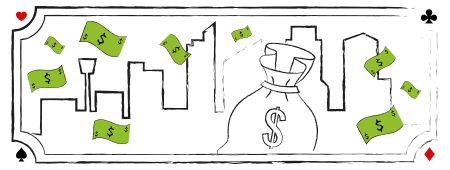
If you are unlucky and lose x amount of dollars, we will rebate you a certain percentage of x. Industry standard, which depends on how much the whale bets and losses, is roughly 10%.
Johnson negotiated a deal with casino bosses before he put any of his money on the green felt. Without going into all the details, here is a summary of his negotiated deal:
- Great playing rules; six-deck with S17, DAS, RSA, and LS that resulted in a game with a very low house edge of 0.26%.
- Allowed to wager up to $100,000 per hand; this was double the allowed table limits.
- Had to deposit one million dollars of front money with the casino; front money is nothing new, but depositing only one million dollars for $100,000 bets was unusual.
- 20% rebate on losses totaling $500,000; the 20% rebate is unusually high and very rare.
It was confirmed by the state gaming regulators who monitored his play that he was not cheating. Johnson also admitted after the fact that he “didn’t bother with card counting because the discount on losses gave me a bigger edge so why bother with card counting?”

HOW YOU CAN GAIN THE EDGE ON A REBATE ON LOSSES
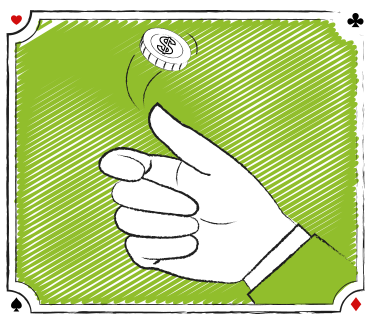
It may not be obvious to you how the 20% rebate on losses can give a player an advantage. On the surface, it would seem that the casino would simply make 20% less money in the long run but still be profitable. Therefore, let me explain how this works with a simple coin toss.
Suppose you were playing heads or tails against the casino. The rules are: You bet $1 on each toss; when you lose, you pay the casino $1; when you win, the casino pays you 99 cents; however, the casino will give you back 20% of your losses if you agree to make at least 100 bets. With these rules, who has the advantage?
Dan Pronovost, who analyzed and wrote two articles on loss-rebates in my Blackjack Insider newsletter, prepared a spreadsheet to analyze the above coin-toss game. Below is a table showing the player’s edge, assuming he took the 20% rebate on losses after a specified number of coin flips. For example, if he took the rebate after one coin flip, he would have a 9.5% edge. If he waited until two coin-flips and then took the 20% rebate, his edge would be 4.55%, and so forth.
What the data showed is that a player would have an initial edge over the casino in this coin-flip game but this edge would gradually decrease as he continued to play before taking the rebate on losses. When he would reach the 320th coin flip, the player’s edge disappears, and if he continued to play this game, the edge would shift in the casino’s favor.
Since the rules specified that you could take your 20% rebate on losses after you made at least 100 bets, a smart player would take the rebate after every cycle of 100 bets to gain the largest edge over the house.

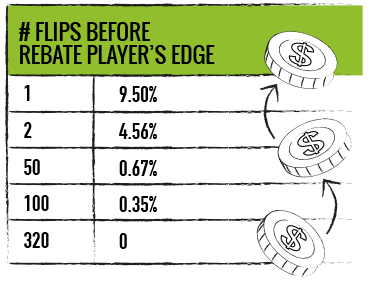
COIN FLIP GAME
Several blackjack mathematicians analyzed Johnson’s rebate on losses deal and published their results in the Blackjack Insider newsletter. Go to www.bjinsider.com, click on Newsletter, then Search engine and type Don Johnson for a list of the articles. Separately, gaming mathematician Eliot Jacobson, Ph.D., published his analysis on his web site www.apheat.net.
Without going into all the math, here’s the bottom line on how Johnson played with an edge and won millions by just flat betting and playing basic strategy:
- He negotiated the sweet 20% rebate on losses, the great playing rules, a larger than normal betting limit, and an unusually low amount of front money with casino bosses.
- He had a big edge on the first hand.
- His edge gradually shifted toward the casino as he continued to play.
- At some point, his edge disappeared and swung in the casinos’ favor.
- He carefully minimized the number of rounds of blackjack he played before asking for his rebate on losses. He knew beforehand when to do this.
You are probably wondering how these three casinos let one player, who was only playing basic strategy and flat betting, i.e., betting the same amount on every hand, win millions of dollars from them? The answer: the casinos didn’t do their homework on the deal Johnson proposed to them, whereas he did.
I’ll close this section with a quote from Eliot Jacoobson, who had done a very detailed analysis on Johnson’s coup.
“It is now clear that there was very little luck involved. Johnson manipulated the “market conditions” he was provided to create conditions he could beat. He then consulted with his mathematical advisers to help create a strategy to optimize his return given all the available parameters of play. He then implemented his plan with an extraordinarily high level of talent that spanned every strategic and tactical nuance. It is humbling, no matter which side of the tables you play, to witness this level of skill, planning and execution. The casinos in Atlantic City didn’t stand a chance.”

KEY TAKEAWAYS:
- Composition-dependent basic strategy considers the individual cards that compose the total of a player’s hand.
- You can reduce the house edge slightly by incorporating C-D plays into your basic strategy.
- Three C-D hard hands that are worth learning are 16 against a dealer 10; 12 against a dealer’s 4; and 15 against a dealer’s 10.
- Hand interaction is a strategy that basic strategy players can use to reduce the house edge against them and even gain a slight edge.
- It is not a technique for the timid player because you will be making a bet on another player’s hand or asking a player to bet on your hand.
- Some hand interactions, especially when you pawn off half of your splits to another player, are considered controversial by some players.
- By adding the value of the casino comps to your expected return when you play blackjack, you can, at a minimum, virtually eliminate the house edge against you.
- It’s also possible to gain the monetary edge over the casino. By playing perfect basic strategy, your expected return is 99.5% (assuming a 0.5% casino edge). If you add the value of comps to the 99.5% return, it’s possible to gain a slight monetary edge (i.e., overall return greater than 100%).
- For more information on how to get more casino comps than you deserve, consult the books Comp City, Frugal Gambling, and More Frugal Gambling.
- Using blackjack coupons can give you the edge.
- Two sources for obtaining gambling coupons are the book American Casino Guide (coupons for Las Vegas area casinos and elsewhere) and the free Members Rewards Book that you receive when you subscribe to the Las Vegas Advisor newsletter.
- If you want to learn more about gambling coupons, I highly recommend the publication Beyond Coupons by James Grosjean, who explains the math for different types of gambling coupons, including a table that shows which casino games and bets are best to play with each type of coupon. The publication also has information on playing strategy deviations for some blackjack coupons. You can read or download the publication at www.blackjackforumonline.com/content/beyondcouponsbjfo.pdf
- High Rollers playing blackjack (or any casino game) can negotiate a rebate on their losses with casinos
- By negotiating a sweet deal, it’s possible for a basic strategy player to gain the edge at blackjack

TEST YOURSELF
Try answering the following questions based on the information in Chapter 5.
- What is C-D basic strategy?
- How would you play a 5-7-4 against a dealer’s 10 upcard?
- How would you play 10-2 against a dealer’s 4 upcard in a multi-deck S17 game?
- You hold 10-5 and the dealer’s upcard is a 10 in a multi-deck game with surrender. Should you surrender the hand?
- Give one example of Hand Interaction.
- You always have the edge on a blackjack hand when you use a gambling coupon. True or False.
- Name one publication that has gambling coupons that you can use when you play blackjack.
- What technique can a high roller use to perhaps get the edge over the casino using only basic strategy?
Answers
- Basic strategy that considers the composition of the cards in your hand.
- You should stand.
- You should hit.
- Yes.
- Any of the following: Adding chips to a fellow player’s double down if he doubles for less; pay a player for his even money wager; convince another player to go partners with you on specific pair splits.
- True.
- Members Reward book (Las Vegas Advisor newsletter) or American Casino Guide book.
- Negotiating a rebate on losses with the casino.
Written by Henry Tamburin Ph.D.

